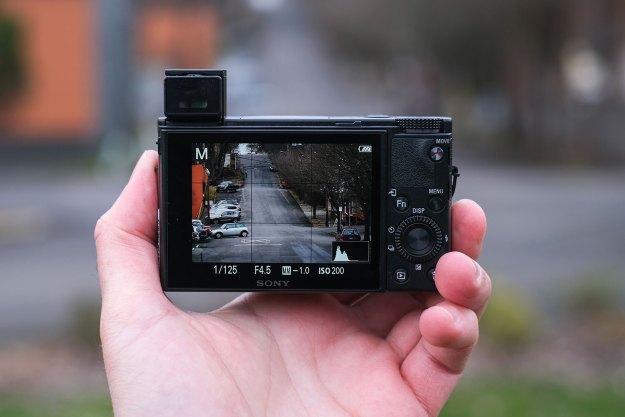As a tribute to the cameras that have pushed the boundaries of photography, motion graphics designer Potero Delantero has created an animated short that takes us through a timeline of camera technology.
Below is a list of each camera shown in the video, as well as a brief history of each camera model.
Kodak Brownie: Introduced in February 1900, the Kodak Brownie camera is widely considered the first camera designed for consumer photography thanks to its simple design and affordable price.
Leica III: First released in 1933, the Leica III continued Leica’s iconic rangefinder design. Over eight different variations of the Leica III were manufactured through 1960, with the Leica IIIg being the last update.
Rolleiflex Automat: Released in 1937, the Rolleiflex Automat won the Grand Prix award at the Paris World’s Fair that year. It was also the first Rolleiflex camera to feature an automatic film counter, which removed the need to read the film shot through a small, red window often seen on the rear of cameras at this time.
Graflex Pacemaker Crown Graphic: Deemed the ultimate workhorse by professional photographers and photojournalist, this 4-by-5-inch camera offered the best bang for the buck and is still considered a reliable camera for photographers looking to get into large format photography.
Afga Clack: Produced between the years 1954 and 1965, this adorable little camera was the ultimate point and shoot of its time, with more than 1.65 million produced in those eleven years. It had only one shutter speed and captured 6-by-9 negatives on 120 film.
Hasselblad 500 C/M: Introduced in 1957, the extremely customizable Hasselblad 500C/M was the solution to Hasselblad’s issues with its focal plane shutter models that preceded it. Besides the iconic cuboid shape of the camera, almost all internal components were reconstructed. The 500 in its name is derived from the fastest shutter speed it offered, 1/500th of a second.
Kodak Instamatic 100: This little camera was one of the first Instamatic cameras Kodak released in the United States. It used the incredibly small 126 cartridge film format. It retailed for approximately $100 throughout its manufacturing period between 1963 and 1966.
Rollei 35: At the time of its release in 1966, the Rollei 35 was the smallest 35mm film camera in existence. Over 2 million Rollei 35 series cameras were manufactured in the 30 years following its release.
Polaroid SX-70: You can’t look at the history of photography without acknowledging this beauty. Designed by Polaroid founder Edwin H. Land, the SX-70 was the first instant camera that had a self-contained photo. Until then, you had to follow precise instructions and peel apart film, which left behind a messy residue. It was produced between 1972 and 1981 and went through multiple model variations.
Pentax K-1000: Unveiled in 1976, the K-1000 might not look like much, but its place in photography history is cemented for its simplicity in design, which made it an affordable camera that could take a beating and keep on clicking. Over 3 million units were sold between 1976 to 1997.
Canon A-1: Produced between 1978 and 1985, the Canon A-1 was the first SLR camera to include an electronic autoexposure mode driven by a small microprocessor attached to a light meter. It was constructed of an aluminum alloy and retailed for around $400 in a kit that included Canon’s 50mm f/1.4 SSC lens.
Kodak DC210: Released in 1998, the DC210 featured a whopping 1-megapixel sensor. Kodak was still very deep in its analog photography business, but the DC210 showed it wasn’t afraid to dip its toes in and push forward the consumer digital camera market. Despite this, we all know the unfortunate path the Kodak brand has taken.
Nikon D1: On June 15, 1999, the D1 became the first DSLR camera Nikon ever produced. Its ability to work seamlessly with Nikon F-mount lenses helped drive its success since it meant spending less in investing in the new, digital camera technology. Interestingly, the D1 captured images in the NTSC color space.
Panasonic DMC LX3: Considered the pinnacle of point-and-shoot cameras for its time, the Panasonic Lumix DMC-LX3 was released in 2008 and offered an impressive 10 megapixel sensor with a maximum sensitivity of 3200 ISO.
iPhone 6: You could argue that many other phones had unique camera features integrated well before the iPhone 6 came along, but considering its ongoing ubiquity and still-impressive image quality, it’s hard to pass it up. One could argue the iPhone lineup as a whole was an influential factor in the transition of photography to more people than ever.
What cameras are missing from the list? Was there a certain camera that drove you to become a photographer or inspire you to create the work you do?
Editors' Recommendations
- Watch how this 2001 news item reported the first (super basic) camera phone
- 5 reasons I love the Leica M11 camera and 5 reasons I don’t
- The best full-frame cameras
- The best mirrorless cameras
- The best vlogging cameras




